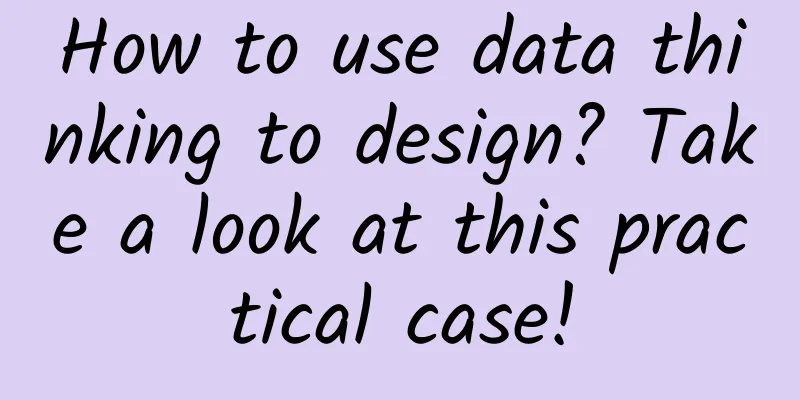How to use data thinking to design? Take a look at this practical case!

|
When we enter the daily experience design process, most of the standard processes will conduct user interviews, competitive product analysis, and usability testing, etc., and this is only done by relatively standardized teams. It is also a process link that my team often conducts. Before this, the design was more based on intuitive experience judgment. But even so, it is impossible to directly determine "which solution is better?" This makes the derivation of the design solution somewhat subjective, which is particularly obvious in C-end projects.
Regarding some concerns or doubts in the design review process, such as:
Under conditional or non-0-1 projects, we must cultivate our data awareness and regard experience design as a "scientific experiment" to discover problems from factual data, find the essence of the problem, and finally verify the effectiveness of the solution. This awareness requires some patience for non-science students, but it is indispensable for us experience designers. So how to implement it in practice? After summarizing and analyzing the double diamond model and the five-leader theory, a process framework is summarized: If it is a 0-1 project or the early exploration stage of product growth, it is not impossible to apply the above process. The main thing is that different methods and strategies are needed in the early stages. The current product platform is already a mature product of relatively large scale. On the one hand, users have gradually formed inherent habits, which makes it unsuitable for drastic iterative optimization of large versions; on the other hand, small experience revisions based on data research are easier to verify data. Taking a recent project on loan-installment repayment as an example, based on the above framework process, we will explain how to analyze and optimize the revision from data in this process. (Currently in our team, the larger the function or version iteration, the more preliminary research and analysis steps are required. The cash loan installment repayment process in the loan product is relatively simple, so we only did a/b test and data research verification in the early stage) Clear demandsThe basic requirement for measuring the value of design is to solve problems. The pain points of the problem are often the final manifestation of the demand. Clarifying the demand is the first step, but the concept of business demand does not seem to be so easy to define. But according to the description of the five designers, it should first include the following four parts:
Secondly, to clarify the demands, we not only need to obtain the essential background and pain points of the problem from the business side, but also need to actively collect and summarize information to obtain the underlying logic of the demands from multiple angles (users). This involves the analysis and sorting of data, especially for e-commerce, big data platforms and various user-facing businesses. We need to establish indicator dimensions from a series of information such as buried data, analysis platform statistics, background reports, etc., set key measurement scales, and analyze the bumps and bumps of the project. In this process, I need to use target thinking as a direction and combine structured thinking to disassemble and extend the needs behind the phenomenon. (Recommended analysis methods: PEST analysis method, 4P marketing theory, DuPont analysis method, Pirate model and variant analysis, logic tree analysis, which will not be elaborated here, and there will be related articles to expand in detail later) Returning to the installment repayment of cash loans, installment repayment is not only a way of life that provides users with a short-term solution to economic pressure (user value), but also increases the company's profit margin (commercial value) through installment. The installment business is the core of the company's business. Optimizing the user's installment experience and reducing the user's repayment overdue rate are important core indicators. The core demand of this demand is to reduce the user's repayment overdue rate. Summarize problems and analyze pain pointsThe user experience goal is actually the goal of user demands. This scenario is mainly suitable for products that are not 0-1. After all, the product has not yet been formed and determined, so there is no need to talk about user feelings and related demands and pain points. The primary goal is survival. User demands are based on specific user groups and specific situational environments. The judgment of the group and situational environment must be closely linked to the business and based on this premise. In a sense, the problems and pain points we need to face and solve are the deep-level manifestations of user demands. The process of "sorting out problems and analyzing pain points" in a situational environment is an important part of forming design goals. Summarizing problems and analyzing pain points here does not simply point out what users want. It should include three parts, namely:
In addition, we can also find analysis points that can be cut in from specific test data. For example, the installment settings for shopping installments and cash loan installments are generally on the product details page, and the conversion funnel from the product list page to the product details page according to the pirate model is 36%, while the conversion from the product details page to the installment setting or the order details page to the funnel conversion drops to 16.9%. B 1. Problems and pain pointsDefine business goals and set design objectivesThe so-called business goal is the upgrade and optimization of business demands after thinking about and improving user demands. Its expression is the integration of the three content descriptions of complete user value, complete value realization strategy, and complete value realization method. From the demand of installment repayment, it is: the installment business goal = using installment form to reduce the economic pressure of users' lives (user value), while realizing the added value of company value realization (realization value). As can be seen from the above figure, design goals are actually subordinate to business goals, and design goals serve business goals. As designers, whether they are interaction designers, experience designers, UI designers, or operation designers, we must clearly know what the complete business goals are. We just need to focus on the design goals, participate in and collaborate to achieve business goals from a professional perspective, with professional expertise, and through professional design strategies. Generally speaking, within a company, all requirements have a basic goal or purpose. It can be a sentence, a document, or a small indicator value. If time permits or if we can control it, we recommend that you do a simple sorting or disassembly. Here we recommend Barbara Minto's pyramid thinking. The above analysis can be the thinking of an interactive experience designer, or it can be the thinking of a UI or operation designer to come up with a creative plan. The purpose is to make our design plan stand up and make sense, and no longer be an experience-based design or a reference design. Set measurement indicators based on design goals and design experience solutionsIn fact, in many cases, design requirements do not necessarily require us to consider design goals. We just need to have a rough assessment. After we output the solution, does the design requirement reflect our design value? What are the indicators for measuring this design value? Indicators are the digital expression of the abstract concept of goals. They can form a specific focus for all participants, establish a unified dimension and judgment standard, and directly reflect the gap between the effect of the solution and the goal. The setting of indicators should be based on specific analysis of specific situations and targeted settings, that is, follow the derivation of "VSM". The so-called "VSM" refers to the process from Value to Signal and then to Metric. Back to the installment repayment requirements, the key measurement indicators include the following: After confirming the key indicators that need to be paid attention to in this demand, we will go back and sort out the entire process of user shopping. As shown in the figure above, we have split the business goal of reducing user delinquency rates and optimizing installment experience into three requirements (excluding operational activities) and handle them separately.
As mentioned above, this time we only explain the case of installment repayment needs, and do not consider other cases for the time being. Therefore, for the second point, there is room for improvement in the experience of installment settings and repayment information processing between the product details page and the order details page. In order to avoid our design scheme being disordered or without foundation, we need to form an interpretation of the design idea before delivering or reviewing the scheme. Of course, this idea is not made up out of thin air, it needs a clear thinking path. We can construct the design scheme from the design strategy in the design goal, or derive possible design strategies from key measurement indicators, and can follow both the "SKS" idea and the "KSS" idea. How many design solutions or design ideas can be derived depends on the designer's own professional ability and the depth of understanding of the business. At this time, we must make a choice among these solutions, which can be through internal review or self-assessment. The feasibility and suitability of self-assessment design solutions need to abide by relevant design principles. For example, the demand for installment repayment is subordinate to the great demand of reducing the overdue rate, and it must comply with unified design principles: Deducing different design solutions based on different design directions and strategies, and conducting design verification Design plan (not final plan):
Design plan (not final plan):
Test and post-launch data summary and analysisAfter completing the plan as an interactive experience designer, some teams need to directly output high-fidelity design drafts, while others will transfer to the UI designer link. No matter which method is used, we need to follow up the progress at any time. After the plan is drafted, we can conduct user interviews and questionnaire surveys before the plan goes online based on different project resources. The main thing is to use the new and old versions as A/B tests for grayscale testing to compare the impact of single variables in different modules on users under the same circumstances.
Because the final requirements have not yet entered the actual line, and the survey feedback on this design plan has not yet been given, I will not explain the relevant data in depth for the time being (even if there is real data, I will only show you fake data). SummarizeData verification design does not mean that every designer needs to be proficient in statistics and study mathematical problems in depth, but rather try to use data thinking to set goals, decompose problems, design solutions, and verify online solutions. It can be called a way to serve the business "from the end to the beginning". It can better help designers communicate with the business side and prove the value of design. In the future, we will also conduct more design deductions based on the collection and analysis of existing data to make a more "scientific" design. The following experiences can be reused in the future: 1. A/B testing is suitable for testing single element variablesFor scenarios such as copywriting, operations, and pictures, longer processes require split testing to accurately locate the influencing elements and find the best combination. 2. Small amounts of data are still effectiveEven if only a small number of conversions are generated in a short period of time, it is still possible to quickly determine which version the user likes best. At the same time, the time and manpower consumed by the test must be controlled and not abused. 3. Successful elements are reusableFor example, if you use A/B testing to find a form or page design that brings good conversions for your service, you should reuse it or upgrade it later. 4. Greatly reduce the risk of revisionAvoid risks and maximize resource utilization when making major decisions or when there are disagreements. Finally, let’s end with a point of view from Jon Wiley, Director of Immersive Design at Google:
|
<<: Google launches next developer preview of Android 12
>>: The app you exited always restarts suddenly? Beware of privacy leaks
Recommend
Weibo hot search was shut down for a week, resulting in a loss of tens of millions. Revealing the industrial chain behind Weibo hot search!
At 9:30 p.m. on January 27, Weibo shut down the “...
Apple's third quarter report: iPhone is strong, iPad is weak
The latest Apple 2014 fiscal third quarter report ...
10 new customer acquisition methods you must know in the early stages of product promotion!
Many Internet products rely on a single breakthro...
I am having a great time traveling, but why are there always these cunning bugs trying to harm me?
It is inevitable to encounter various kinds of in...
"Mars opposition" is happening today! Don't miss the best time to observe "Mars".
It's a good time to observe Mars. Astronomy e...
Electric Technology Car News: The family-style design has attracted a lot of criticism. Can the twin brother of Trumpchi GS8 continue the legend?
Data in recent years show that although 7-seat SU...
The mini app can also track checked luggage, so you can finally know where your luggage is.
Every time I take a plane and wait for my luggage...
Is it true that “not eating after noon” can help you lose weight?
Audit expert: Shen Yingjian Director of the Nutri...
Pay attention to these 5 points when eating pickled cabbage safely! Hardcore content is coming!
Recently, because the 3.15 Gala exposed the probl...
How to plan an anniversary event? Teach you step by step
This article is a homework assignment, which is t...
If you want to understand the Romance of the Three Kingdoms, start with Fatty Dong!
What else do you want to read but haven't rea...
Weilong Spicy Tiao Mobile Game is here!
While many traditional companies are still doing ...
Baise Moving Mini Program investment price inquiry, how much is the Baise Moving Mini Program investment price?
What is the investment cost of Baise Moving Mini ...
User Growth Formula: Pinduoduo’s Growth Game Thinking
Nowadays, we can often see some gamification sett...
Another "world's best" is officially delivered!
On March 30, the reporter learned from China Nati...









